Complete text and all illustrations for the monograph [1e] by Dr Jan Pajak,
"Advanced Magnetic Propulsion Systems" (1990, ISBN 0-9597698-9-7)
Links to illustrations and related texts:
Labels: The label "E" marks the web page with text of English-language version of this monograph.
The label "1st, 2nd, 3rd Figures" mark the web pages with illustrations for subsequent volumes and chapters.
The label "P" marks the web page with text of a Polish-language equivalent of this monograph.
The label "X" marks the web page with the text of English-language version of this monograph
which is designed so as to load much faster because it does NOT show graphics at the loading
stage but only after the user clicks on subsequent Figures to display them.
Chapter L:
 [1e] Figure L1 (a): Detached configuration of two UFOs. (a) The external appearence of such configuration. [1e] Figure L1 (a): Detached configuration of two UFOs. (a) The external appearence of such configuration.
 [1e] Figure L1 (b): A vertical cross-section through such a UFO. [1e] Figure L1 (b): A vertical cross-section through such a UFO.
 [1e] Figure L1 (c): A whole photo showing the detached configuration. [1e] Figure L1 (c): A whole photo showing the detached configuration.
 [1e] Figure L1 (d): Enlargement of the vehicle - it clearly shows the "black bars" running between side propulsors. [1e] Figure L1 (d): Enlargement of the vehicle - it clearly shows the "black bars" running between side propulsors.
 [1e] Figure L1 (e): The same configuration a while later. [1e] Figure L1 (e): The same configuration a while later.
 [1e] Figure L2 (a): "Black bars" in a spool-shaped UFO. [1e] Figure L2 (a): "Black bars" in a spool-shaped UFO.
 [1e] Figure L2 (b): A reconstruction of the witness of a spool-shaped UFO type K3, Brazil, 1969. [1e] Figure L2 (b): A reconstruction of the witness of a spool-shaped UFO type K3, Brazil, 1969.
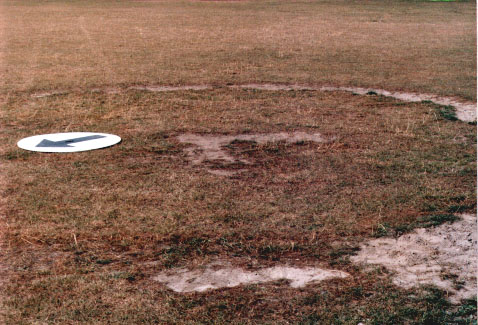 [1e] Figure L3: A UFO's twin-chamber capsule scorched in grass, exactly as shown in Figure F5 - outer chamber flux domination. [1e] Figure L3: A UFO's twin-chamber capsule scorched in grass, exactly as shown in Figure F5 - outer chamber flux domination.
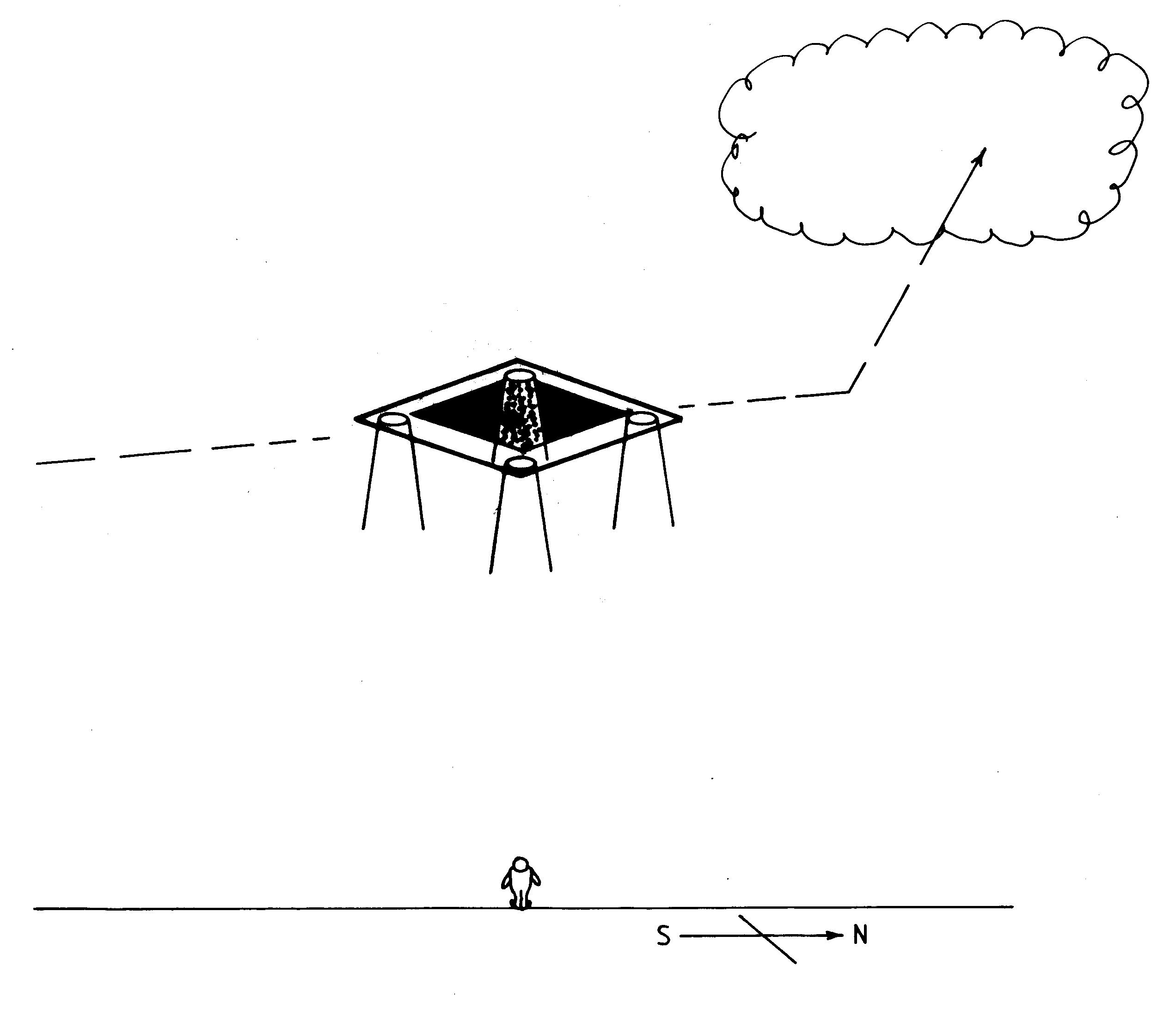 [1e] Figure L4: A drawing of the day-time twin chamber capsule visible in an ascending UFO, exactly as shown in Figure F5 - outer chamber flux domination. [1e] Figure L4: A drawing of the day-time twin chamber capsule visible in an ascending UFO, exactly as shown in Figure F5 - outer chamber flux domination.
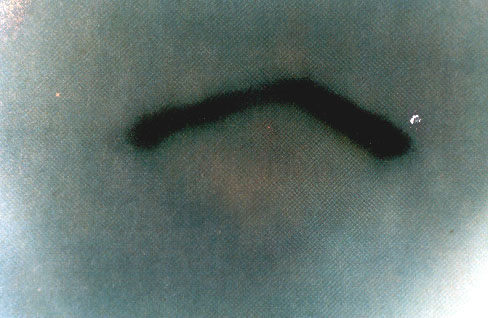 [1e] Figure L4 (b): Colour photograph of a UFO capsule during daylight (inner flux prevailence). [1e] Figure L4 (b): Colour photograph of a UFO capsule during daylight (inner flux prevailence).
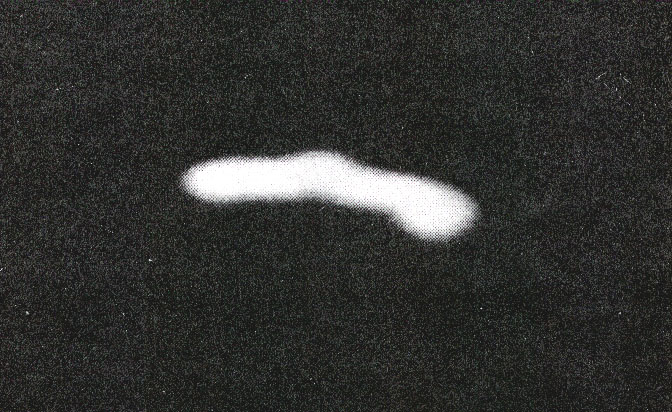 [1e] Figure L5: Night photograph of a UFO capsule (outer flux prevailence). [1e] Figure L5: Night photograph of a UFO capsule (outer flux prevailence).
 [1e] Figure L6 (left): Oscillatory Chambers seens on UFO decks. (left) The predicted appearence of such a chamber. [1e] Figure L6 (left): Oscillatory Chambers seens on UFO decks. (left) The predicted appearence of such a chamber.
 [1e] Figure L6 (right): Observed appearence of a real Oscillatory Chamber from deck of a UFO. [1e] Figure L6 (right): Observed appearence of a real Oscillatory Chamber from deck of a UFO.
 [1e] Figure L7: An ancient plan for an Oscillatory Chamber?. [1e] Figure L7: An ancient plan for an Oscillatory Chamber?.
Chapter M:
 [1e] Figure M1 (up): An imprint of a leg from a K5 type UFO that landed in Maitland, New Zealand. (The wite disk is exactly 1 meter in diameter, while its arrow is pointing North). [1e] Figure M1 (up): An imprint of a leg from a K5 type UFO that landed in Maitland, New Zealand. (The wite disk is exactly 1 meter in diameter, while its arrow is pointing North).
 [1e] Figure M1 (down): One of four imprints of legs from K6 type UFO. [1e] Figure M1 (down): One of four imprints of legs from K6 type UFO.
Notice that because of the large size of this illustration, it cannot be shown on web sites *.50megs.com that limit the size of a file to 250 KB. You may see this illustration on web sites *.20m.com.
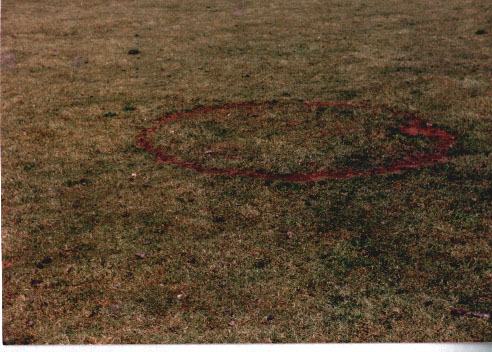 [1e] Figure M2 (upper): A landing of K3 type UFO composed of one ring and a central scorching. [1e] Figure M2 (upper): A landing of K3 type UFO composed of one ring and a central scorching.
 [1e] Figure M2 (lower): Children standing on this UFO landing (to give some idea about its size). [1e] Figure M2 (lower): Children standing on this UFO landing (to give some idea about its size).
 [1e] Figure M3 (up): A K5 type UFO landing scorched in the throbbing mode of operation - aclose up.(Maitland, New Zealand). [1e] Figure M3 (up): A K5 type UFO landing scorched in the throbbing mode of operation - aclose up.(Maitland, New Zealand).
 [1e] Figure M3 (down): The same K5 type UFO landing site photographed from a distance. [1e] Figure M3 (down): The same K5 type UFO landing site photographed from a distance.
 [1e] Figure M4 (up): The UFO landing site at Ngatea, New Zealand. [1e] Figure M4 (up): The UFO landing site at Ngatea, New Zealand.
 [1e] Figure M4 (down): The UFO landing at Tooligie Hill, Australia. [1e] Figure M4 (down): The UFO landing at Tooligie Hill, Australia.
 [1e] Figure M5 (up): A landing of George Pedley, Tully, Queensland. [1e] Figure M5 (up): A landing of George Pedley, Tully, Queensland.
 [1e] Figure M5 (down): A landing in Nourradons, France. [1e] Figure M5 (down): A landing in Nourradons, France.
 [1e] Figure M6 (up): A dounble-ring site by a K6 UFO in Waikoikoi, New Zealand. [1e] Figure M6 (up): A dounble-ring site by a K6 UFO in Waikoikoi, New Zealand.
 [1e] Figure M6 (down): A double-ring landing by K6 UFO in Palmerston, new Zealand. [1e] Figure M6 (down): A double-ring landing by K6 UFO in Palmerston, new Zealand.
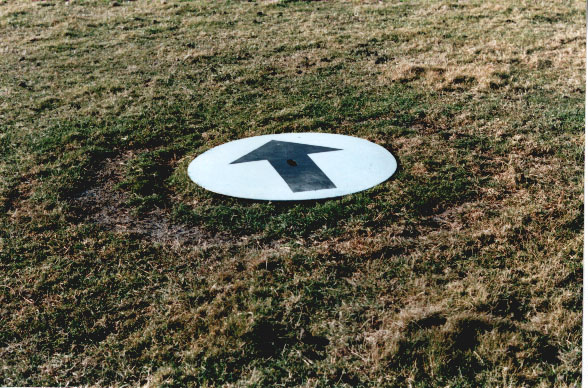 [1e] Figure M7 (upper): A photo of a UFO landing composed of two concentric rings. [1e] Figure M7 (upper): A photo of a UFO landing composed of two concentric rings.
 [1e] Figure M7 (lower): An elliptical landing of K3 type UFO from Genmell's silage paddock. [1e] Figure M7 (lower): An elliptical landing of K3 type UFO from Genmell's silage paddock.
 [1e] Figure M8 (high): A photo of landing of K4 UFOs in Waikoikoi, which shows soil sampling. [1e] Figure M8 (high): A photo of landing of K4 UFOs in Waikoikoi, which shows soil sampling.
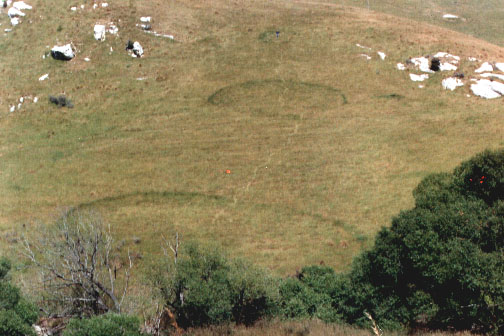 [1e] Figure M8 (lower): A photo of landing of K4 UFOs which document the binary progression in sizes of UFOs (i.e. the fact that each bigger type of UFOs is twice as big as previous type). [1e] Figure M8 (lower): A photo of landing of K4 UFOs which document the binary progression in sizes of UFOs (i.e. the fact that each bigger type of UFOs is twice as big as previous type).
 [1e] Figure M9 (up): A K5 UFO landing in Palmerston, New Zealand - close up. [1e] Figure M9 (up): A K5 UFO landing in Palmerston, New Zealand - close up.
 [1e] Figure M9 (down): A distant view of the same K5 UFO landing. [1e] Figure M9 (down): A distant view of the same K5 UFO landing.
 [1e] Figure M10 (up): A K7 UFO landing at "Shellrock Farm", Weka Pass. [1e] Figure M10 (up): A K7 UFO landing at "Shellrock Farm", Weka Pass.
 [1e] Figure M10 (down): A K7 UFO loanding in Chapman's paddock, Goodwood, New Zealand. [1e] Figure M10 (down): A K7 UFO loanding in Chapman's paddock, Goodwood, New Zealand.
 [1e] Figure M11: A K8 type UFO landing in Glendhu Bay, Wanaka. (The UFO landing is that circle of burned vegetation visible just above my head on the slope of the mountain. In spite that on the photograph it look rather small, in reality it is almost 100 meters in diameter.) [1e] Figure M11: A K8 type UFO landing in Glendhu Bay, Wanaka. (The UFO landing is that circle of burned vegetation visible just above my head on the slope of the mountain. In spite that on the photograph it look rather small, in reality it is almost 100 meters in diameter.)
 [1e] Figure M12 (a): Examples of landings of flying systems of UFOs. A single ceel of a flying system. [1e] Figure M12 (a): Examples of landings of flying systems of UFOs. A single ceel of a flying system.
 [1e] Figure M12 (b): Four-Clover landing of a single cell of a flying system. [1e] Figure M12 (b): Four-Clover landing of a single cell of a flying system.
 [1e] Figure M12 (c): An aerial view of a K3 single cell of UFOs from Roxburgh. [1e] Figure M12 (c): An aerial view of a K3 single cell of UFOs from Roxburgh.
 [1e] Figure M12 (d): A closeup of the same single cell of K3 UFOs landing from Roxburgh. [1e] Figure M12 (d): A closeup of the same single cell of K3 UFOs landing from Roxburgh.
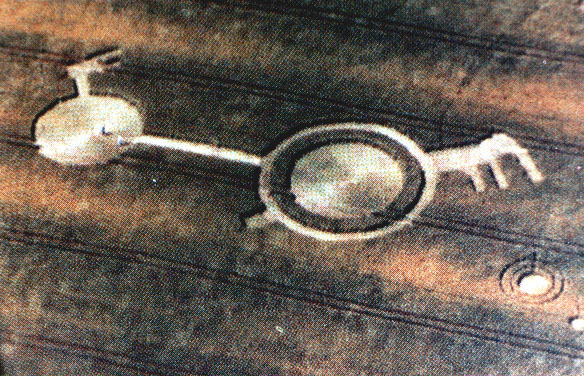 [1e] Figure M13 (up): Landing sites flatten by flying clusters of UFOs. Crop circles from K6 type of UFOs, England. The exact configuration of K6 vehicles which formed this crop circle is shown in Figure F13 from monograph [1/4e], and also in Figure G17 from this monograph [1e]. [1e] Figure M13 (up): Landing sites flatten by flying clusters of UFOs. Crop circles from K6 type of UFOs, England. The exact configuration of K6 vehicles which formed this crop circle is shown in Figure F13 from monograph [1/4e], and also in Figure G17 from this monograph [1e].
 [1e] Figure M13 (down): Interpretation of the UFO landing site shown in the previous part (a) of this Figure. Descriptions of subsequent symbols from this drawing are provided in captions for illustrations from monographs [2e] and [1e], and also in the text of monographs [2e] and [1e]. [1e] Figure M13 (down): Interpretation of the UFO landing site shown in the previous part (a) of this Figure. Descriptions of subsequent symbols from this drawing are provided in captions for illustrations from monographs [2e] and [1e], and also in the text of monographs [2e] and [1e].
 [1e] Figure M14 (up): Permanent UFO landings - the oldest UFO landing noticed around 1920 (but photographed in 1987). [1e] Figure M14 (up): Permanent UFO landings - the oldest UFO landing noticed around 1920 (but photographed in 1987).
 [1e] Figure M14 (down): Mushrooms on a UFO landing site. [1e] Figure M14 (down): Mushrooms on a UFO landing site.
 [1e] Figure M15 (up): A pine tree broken by a hovering UFO type K5 (a distant view). [1e] Figure M15 (up): A pine tree broken by a hovering UFO type K5 (a distant view).
 [1e] Figure M15 (down): Close up of the broken pine. [1e] Figure M15 (down): Close up of the broken pine.
 [1e] Figure M16: A double K8 UFO landing on the slope of mountain near Glendhu Bay, Wanaka. The landing is visible around the centre of this photo. It looks like a digit 3. Each half-circle of this digit 3 is almost 100 meters in diameter. Note that this was a different K8 type UFO vehicle from that shown in Figure M11 above (M11 shows a landing from a single vehicle of K8 type, while this landing is probably left by a cell of flying system of K8 type). [1e] Figure M16: A double K8 UFO landing on the slope of mountain near Glendhu Bay, Wanaka. The landing is visible around the centre of this photo. It looks like a digit 3. Each half-circle of this digit 3 is almost 100 meters in diameter. Note that this was a different K8 type UFO vehicle from that shown in Figure M11 above (M11 shows a landing from a single vehicle of K8 type, while this landing is probably left by a cell of flying system of K8 type).
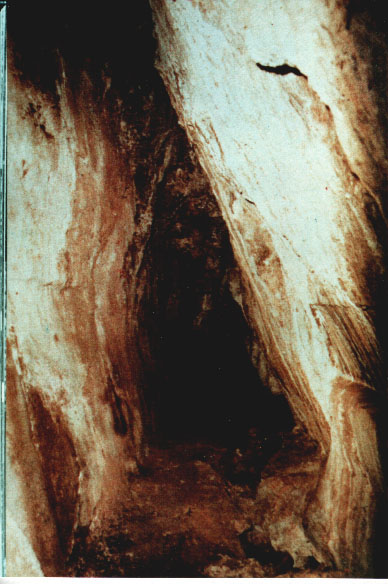 [1e] Figure M17: The tunnel Morona-Santiago in Equador also evaporated by a UFO. [1e] Figure M17: The tunnel Morona-Santiago in Equador also evaporated by a UFO.
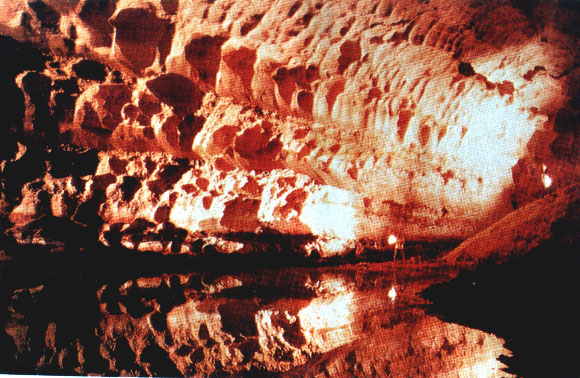 [1e] Figure M18 (a): The Cocklebiddy Cave in Australia evaporated by UFOs. [1e] Figure M18 (a): The Cocklebiddy Cave in Australia evaporated by UFOs.
 [1e] Figure M18 (b): Shape and course of the Cocklebiddy Cave. [1e] Figure M18 (b): Shape and course of the Cocklebiddy Cave.
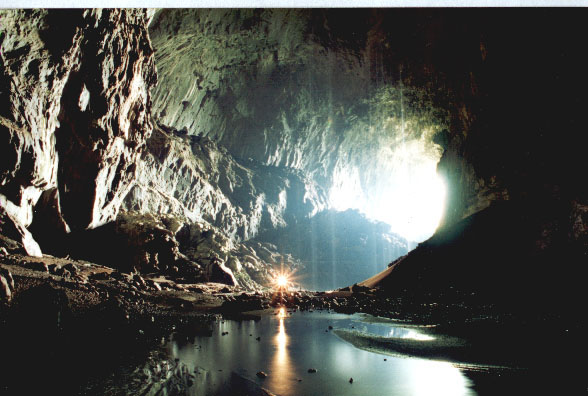 [1e] Figure M18(c): The Deer Cave in Borneor evaporated in rocks by UFOs type K8. [1e] Figure M18(c): The Deer Cave in Borneor evaporated in rocks by UFOs type K8.
 [1e] Figure M19 (upper): A distant photograph of the Tapanui Crater where a UFO exploded in 1178 AD. Note that this crater is around 1 km in diameter, while the tree visible at the top is a fully grown pine.
More interesting curiosities of New Zealand, includin the above crater formed in the result of a UFO explosion near Tapanui, is provided on a separate web page, which in "Menu 2" and "Menu 4" is named
New Zealand. [1e] Figure M19 (upper): A distant photograph of the Tapanui Crater where a UFO exploded in 1178 AD. Note that this crater is around 1 km in diameter, while the tree visible at the top is a fully grown pine.
More interesting curiosities of New Zealand, includin the above crater formed in the result of a UFO explosion near Tapanui, is provided on a separate web page, which in "Menu 2" and "Menu 4" is named
New Zealand.
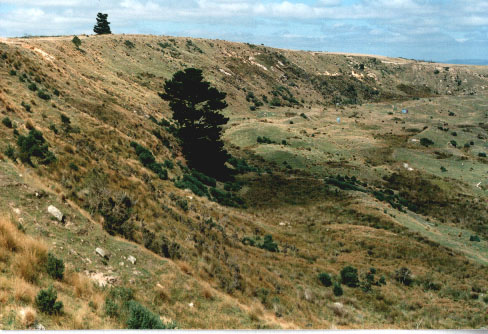 [1e] Figure M19(low): An eastern section of the Tapanui Crater where UFOs exploded in 1178 AD.
More details about the UFO explosion near Tapanui is provided on a separate web page, which in "Menu 2" and "Menu 4" is named
Tapanui. [1e] Figure M19(low): An eastern section of the Tapanui Crater where UFOs exploded in 1178 AD.
More details about the UFO explosion near Tapanui is provided on a separate web page, which in "Menu 2" and "Menu 4" is named
Tapanui.
 [1e] Figure M20 (a): Remains of trees fallen down during the Tapanui explosion. Totara around 200 metres from the Tapanui Crater. [1e] Figure M20 (a): Remains of trees fallen down during the Tapanui explosion. Totara around 200 metres from the Tapanui Crater.
 [1e] Figure M20 (b): Unearthed ancient trees at the outlet from Mataura river. [1e] Figure M20 (b): Unearthed ancient trees at the outlet from Mataura river.
 [1e] Figure M20 (c): Myself (Dr Jan Pajak) by a totara tree at Black Gully Creek. [1e] Figure M20 (c): Myself (Dr Jan Pajak) by a totara tree at Black Gully Creek.
 [1e] Figure M20 (d): Trees sticking out from Black Gully Creek. [1e] Figure M20 (d): Trees sticking out from Black Gully Creek.
 [1e] Figure M21: Damage caused by the Tapanuii explosion in the South Island of New Zealand. [1e] Figure M21: Damage caused by the Tapanuii explosion in the South Island of New Zealand.
 [1e] Figure M22 (high): The inner topography of the Tapanui Crater. (Overhead sketch.) [1e] Figure M22 (high): The inner topography of the Tapanui Crater. (Overhead sketch.)
 [1e] Figure M22 (low): Vertical cross section of the crater's topography. [1e] Figure M22 (low): Vertical cross section of the crater's topography.
 [1e] Figure M23: Two aerial photographs of the Tapanui Crater. They allow a stereoscopic (3D) view of the area - if one uses stereoscopic glasses. (Notice two elliptical images oif the crater, located around Z=40% from the bottom, and X=50% plus X=90% from the left of screen.) [1e] Figure M23: Two aerial photographs of the Tapanui Crater. They allow a stereoscopic (3D) view of the area - if one uses stereoscopic glasses. (Notice two elliptical images oif the crater, located around Z=40% from the bottom, and X=50% plus X=90% from the left of screen.)
 [1e] Figure M24 (high): Photographs of a tornado by Mrs Diane Chittock. This tornado develops the funnel right above the Tapanui Crater.
More details about attributes and mechanism of tornados induced technologically by UFO vehicles is provided on a separate web page, which in "Menu 2" and "Menu 4" is named
Tornado. [1e] Figure M24 (high): Photographs of a tornado by Mrs Diane Chittock. This tornado develops the funnel right above the Tapanui Crater.
More details about attributes and mechanism of tornados induced technologically by UFO vehicles is provided on a separate web page, which in "Menu 2" and "Menu 4" is named
Tornado.
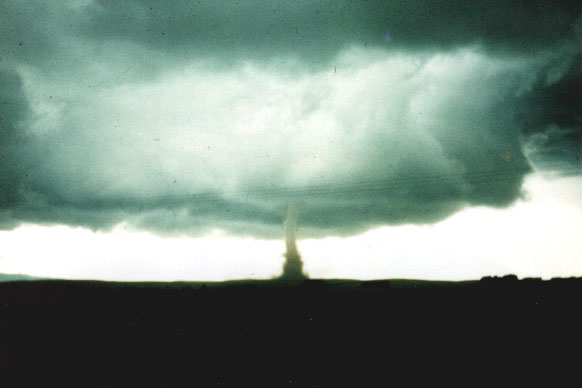 [1e] Figure M24 (low): Photographs of a fully developed tornado by Mrs Diane Chittock. Fully developed tornado drifts away from the crater.
More details about tornados and hurricanes induced technologically by UFO vehicles is provided on a separate web page, which in "Menu 2" and "Menu 4" is named
Tornado. [1e] Figure M24 (low): Photographs of a fully developed tornado by Mrs Diane Chittock. Fully developed tornado drifts away from the crater.
More details about tornados and hurricanes induced technologically by UFO vehicles is provided on a separate web page, which in "Menu 2" and "Menu 4" is named
Tornado.
 [1e] Figure M25: A magnetised metallic piece from Tapanui Crater. Research shown that it contains iron and grains of pure aluminium, mixed with sand and melted. But aluminium does not appear in a pure form in nature! [1e] Figure M25: A magnetised metallic piece from Tapanui Crater. Research shown that it contains iron and grains of pure aluminium, mixed with sand and melted. But aluminium does not appear in a pure form in nature!
 [1e] Figure M26 (upper): A china stone that formad a small crater by Black Gully Creek. [1e] Figure M26 (upper): A china stone that formad a small crater by Black Gully Creek.
 [1e] Figure M26 (lower): Famous China stone from Roxburgh square. A is famous because when it was found a whole pocket of gold was covering its surface. [1e] Figure M26 (lower): Famous China stone from Roxburgh square. A is famous because when it was found a whole pocket of gold was covering its surface.
 [1e] Figure M27 (upper): The Siberian Taiga after the Tunguska explosion. From recent research. [1e] Figure M27 (upper): The Siberian Taiga after the Tunguska explosion. From recent research.
 [1e] Figure M27 (lower): Tunguska Taiga fallen down by a UFO explosion in 1908. A frame from the original old Russian film.
It is worth to know, that the UFO explison of 1908 in Tunguska, Central Siberia, is elaborated in much more details in the monograph [5e], copies of which can be downloaded free of charge via web pages, which in "Menu 2" and "Menu 4" are marked
Text of [5e]. [1e] Figure M27 (lower): Tunguska Taiga fallen down by a UFO explosion in 1908. A frame from the original old Russian film.
It is worth to know, that the UFO explison of 1908 in Tunguska, Central Siberia, is elaborated in much more details in the monograph [5e], copies of which can be downloaded free of charge via web pages, which in "Menu 2" and "Menu 4" are marked
Text of [5e].
 [1e] Figure M28 (a): Parabolic-bowl craters from uderground explosions. Diabolo Crater in Arisona, USA, side view. [1e] Figure M28 (a): Parabolic-bowl craters from uderground explosions. Diabolo Crater in Arisona, USA, side view.
 [1e] Figure M28 (b): Diabolo Crater in Arisona, top view. [1e] Figure M28 (b): Diabolo Crater in Arisona, top view.
 [1e] Figure M28 (c): Axial cross-section of Diabolo Crater. [1e] Figure M28 (c): Axial cross-section of Diabolo Crater.
 [1e] Figure M28 (d): Schooner Crater, USA, formed by a nuclear explosion. [1e] Figure M28 (d): Schooner Crater, USA, formed by a nuclear explosion.
 [1e] Figure M28 (e): Vertical cross-section of the Schooner Crater. [1e] Figure M28 (e): Vertical cross-section of the Schooner Crater.
 [1e] Figure M29 (a): The "Telegraphic Pole" forest left in the ground zero at the site of UFO explosion in Tunguska. [1e] Figure M29 (a): The "Telegraphic Pole" forest left in the ground zero at the site of UFO explosion in Tunguska.
 [1e] Figure M29 (b): The upright trees still standing in Hiroshima Castle. [1e] Figure M29 (b): The upright trees still standing in Hiroshima Castle.
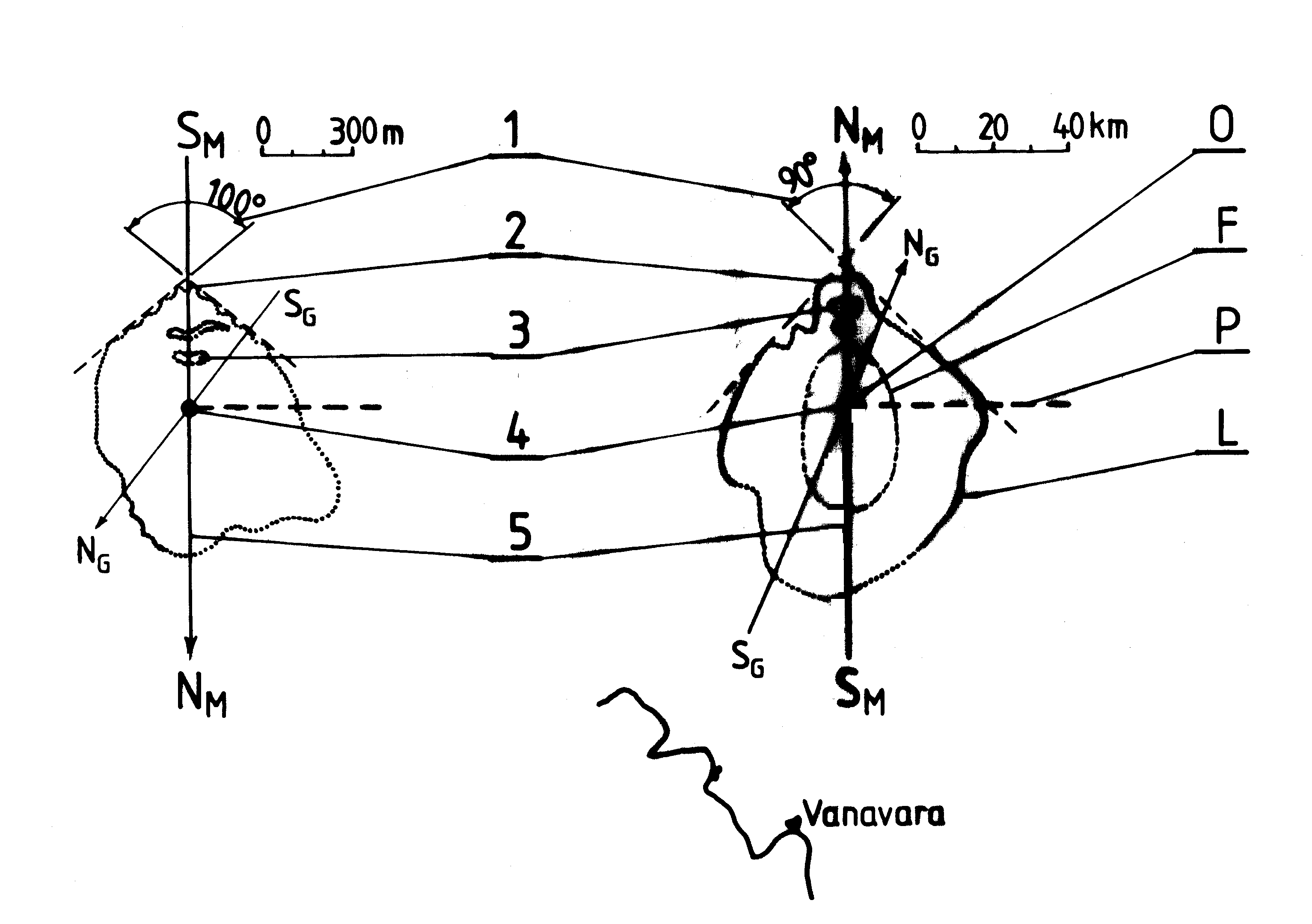 [1e] Figure M30: Similarities between UFO explosion sites in Tapanui, New Zealand, and in Tunguska, Siberia. [1e] Figure M30: Similarities between UFO explosion sites in Tapanui, New Zealand, and in Tunguska, Siberia.
Chapter N:
 [1e] Figure N1: UFOnauts and their vehicle drawn by S. Maslowski (9 years old). [1e] Figure N1: UFOnauts and their vehicle drawn by S. Maslowski (9 years old).
Notice that because of the large size of this illustration, at Web sites "*.50megs.com" it is shown at the cost of its quality. Therefore, in a full quality this illustration can be seen on Web sites at "*.20m.com" servers, e.g. at ufonauts.20m.com.
 [1e] Figure N1 (framed): A drawing of Magnocraft type K3 in the same position as that UFO. [1e] Figure N1 (framed): A drawing of Magnocraft type K3 in the same position as that UFO.
 [1e] Figure N2: A UFOnaut with a glowing belt. [1e] Figure N2: A UFOnaut with a glowing belt.
 [1e] Figure N3: One flash picture of a UFOnaut by Jeff Greenhaw. [1e] Figure N3: One flash picture of a UFOnaut by Jeff Greenhaw.
 [1e] Figure N4: A UFOnaut calling himself "Ausso". [1e] Figure N4: A UFOnaut calling himself "Ausso".
 [1e] Figure N5: A UFOnaut climbing a wall like an insect (it means that a magnetic propulsion was used). [1e] Figure N5: A UFOnaut climbing a wall like an insect (it means that a magnetic propulsion was used).
 [1e] Figure N6: One of several footprint of an UFOnaut left on PVC floor. [1e] Figure N6: One of several footprint of an UFOnaut left on PVC floor.
Chapter O:
 [1e] Figure O1: A four-propulsor UFO which abducted the late Jan Wolski. [1e] Figure O1: A four-propulsor UFO which abducted the late Jan Wolski.
 [1e] Figure O2 (a): A night apearence of a four-propulsor UFO. (a) Witnesse's original sketch of this UFO. [1e] Figure O2 (a): A night apearence of a four-propulsor UFO. (a) Witnesse's original sketch of this UFO.
 [1e] Figure O2 (b): My (Dr Jan Pajak) reconstruction of this UFO. [1e] Figure O2 (b): My (Dr Jan Pajak) reconstruction of this UFO.
 [1e] Figure O3: A photograph of four-propulsor UFO. [1e] Figure O3: A photograph of four-propulsor UFO.
Chapter P:
 [1e] Figure P1: A reduced model of K3 type Magnocraft. [1e] Figure P1: A reduced model of K3 type Magnocraft.
 [1e] Figure P2: A geometrical model of K6 type Magnocraft. [1e] Figure P2: A geometrical model of K6 type Magnocraft.
 Dr Jan Pajak: Photograph of the author of this monograph [1e] "Advanced Magnetic Propulsion Systems", taken in Akaroa, New Zealand in 1983 (i.e. in at the time when this monograph [1e] started to eventuate). Dr Jan Pajak: Photograph of the author of this monograph [1e] "Advanced Magnetic Propulsion Systems", taken in Akaroa, New Zealand in 1983 (i.e. in at the time when this monograph [1e] started to eventuate).
Complete DESCRIPTIONS under illustrations for the monograph [1e] "Advanced Magnetic Propulsion Systems" (in ZIP from WORD "*.DOC" format).
LIST of illustrations and filenames for the monograph [1e] "Advanced Magnetic Propulsion Systems" (in ZIP from WORD "*.DOC" format).
Instructions:
Part G: How to
replicate
this web page in your own computer:
For some readers that work
on problems addressed on this web page, it would be highly
beneficial to have a replica of this web page together with
all the illustrations, texts, links, etc., in their own
computer. After all, in case of having such a replica, one
can later view this web page, or print it, directly from
his/her own computer, not from the Internet. Thus one becomes
independent from the access to Internet in each situation
when he/she wishes to have a good look at this web page or
at illustrations that this page displays. Waiting for
opening a web page is then also incomparably shorter
than waiting for opening an Internet page. It is then
also not needed to put up with all these subtle obstructions
which seem to plague my web pages almost as it these are
purposely sabotaged by "little green UFOnauts" of some sort.
So for these readers, who wish to make a "source replica"
of this web page in their own computer, below I am describing
step-by-step how to accomplish this. This description reveals
thoroughloy how to prepare the so-called "source replica" of
the web page, means a replica prepared in the programming
language called "HTML" in which this web page was originally
coded. Note that such a "source replica" is much better than
an "image replica" that almost every browser allows to make
in quite a simple way. For example it allows to gradually
complete all missing components of a given web page (e.g.
missing illustrations or text files) from other servers.
It alows to update separately each selected component of
the web page as soon as we meet in Internet their better
versions. It also allows us to learn principles of web
page programming, thus it can be for us a first step towards
later making our own web pages. Here is the instruction
of producing such a "source replica":
#0. Ready-made source replica?
(without advertising banners). One brief information before in items
#1 to #8 below I explain the exact procedure of preparing for yourself
a source replica of this web page. Namely, under some addresses listed
in "Menu 3", such a source replica of this web page, together with
all folders, source codes of web pages, samples of texts and illustration,
etc., but without advertising banners, already awaits in the ZIP format,
ready for downloading to your own computer. So all what you need to
do in order to download it to your own computer, is to click in
"Menu 1" on the menu item marked
"Source replica of this page".
So try to click, because this source replica may be available here
(i.e. at this address) and it would be handy to have it in your
own computer. In turn, when such a ZIPped source replica downloads
to your computer, all what you need to do is UNZIP it onto your
hard disk. After UNZIPing, it forms a separate folder in which
you will find a folder named "a_pajak" with all source files,
subfolders and samples of text and illustration inside, ready for
the running, testing, displaying, and checking how all these work
on your own computer. All what you later need to do in your spare
time is to download to text folders remaining volumes of monograph
[1/4], while to folder 14 download the remaining illustrations,
which could not be included to the ready-made source replica
because of their volume. (Note that in case you already have on your
hard disk a folder named "c:\a_pajak" with
my other source web pages, it is enough if you transfer all files and
subfolders from this new folder "a_pajak" to the already existing one
named "c:\a_pajak".) After this brief information, let us now return
to this procedure of making (all by yourself) a source replica of this
web page. Here it is:
#1. Create a folder
named "a_pajak" (or "archives_pajak") on your hard disk "c:".
This folder is to hold this web page (and possibly also any
other my web pages). To create such a folder, run a utility
program named "Windows Explorer" or "My Computer", choose
"Local Disk (C:)" for the "Address" in this utility program,
then click on "File" in the pull-down menu from this "Windows
Explorer", then click "New", finally choose the command "folder".
Type the name "a_pajak" to the new folder that you created
on you hard disk. Later you are to use this folder "a_pajak"
for storing all my web pages, monographs, and illustrations
that you wish to keep in you own computer.
#2. Create sub-folders
inside of this main folder named "a_pajak". These sub-folders are
to contain subsequent kinds of texts and illustrations displayed
or accessed through this web page. Here is the list of sub-folders
that are used by this web page:
14 - it contains all the illustrations which are used by
monograph [1e] (and thus also this web page), and also are used
in monograph [1/4].
54 - it contains all the illustrations which are used by
monograph [1e] (and thus also this web page), and also are used
in monograph [5/4].
flags - it contains images of flags (i.e. German, Spanish,
French, Italian, Polish, and English) used in my web pages. These
images of flags are contained in files named de_flag.gif, es_flag.gif,
fr_flag.gif, it_flag.gif, pl_flag.gif, uk_flag.gif. Any flags
scanned into "*.gif" files with the above names, can be used for
this purpose.
1e - it contains the source text of monograph [1e] in English,
plus all illustrations unique to this monograph [1e].
In order to create such sub-folders, again it is enough to shift
the "Windows Explorer" inside of the folder "a_pajak" and then
generate them one by one.
#3. Save the source code of this web page
in your folder "a_pajak". For this, "right click" on your mouse while pointing
it any text area of this web page (e.g. pointing right here). A small menu
should appear, which is to have the option "View Source". Click on this menu
option, and the source code of complete this web page appears in your text
editor named "Notepad". Click on the "File" pull-down menu from this "Notepad"
and choose the option "Save As...". Save the source code from your "Notepad"
using the name "figs_1e_3.htm" for the "File name" of this code, while for
the "Save in" pointing at the folder "c:\a_pajak" that you created earlier.
Notice that pages called via links from this page, should be saved
under slightly different names, namely:
"figs_1e_1.htm" for the page with illustrations (1),
"figs_1e_2.htm" for the page with illustrations (2),
"figs_1e_3.htm" for the page with illustrations (3).
In order to save the text of (scrollable) "Menu 4", you need to firstly
display it on the screen, by clicking on it from either "Menu 1" or "Menu 2",
and only then you can save the source code of it under the name "menu.htm"
in a manner identical as you save the source code of this web page.
Also all pages called from this page via links in "Menu 1" or "Menu 2", should
be saved almost identically as you save this web page, only that you use
slightly different names assigned to them, e.g names: "oscillatory_chamber.htm"
for the web page on the "Oscillatory Chamber", "magnocraft.htm" for the web
page on "Magnocraft", "tekst_1_4.htm" for the Polish version of this web
page, etc.
#4. Save illustrations. Right click
separately on each illustration from this web page, then choose the option
"Save Picture As". The majority of illustrations you need to save in the
subfolder "14". Remaining in subfolders [54] and [1e]. Notice that each
illustration indicates at the bottom of the screen the subfolder in which
it is to be saved.
#5. Run this web page in your computer.
After you save this web page, you can run it in your own computer whenever
you wish, by simple pointing at the file "figs_1e_3.htm" (i.e. the one with
the source code of this web page) using the "Windows Explorer" for this pointing,
and then double clicking at this file. (You can also run this file by pointing
the "Windows Explorer" at it, and then pressing "Enter".) Pages linked with this
one via hyperlinks can also be displayed through clicking on these hyperlinks
while viewing this page, or can be displayed through clicking via the "Windows
Explorer" at their names, means e.g. at "figs_1e.htm", "figs_1e_1.htm",
"figs_1e_2.htm", "figs_1e_3.htm", "oscillatory_chamber.htm", "magnocraft.htm",
"pajak_jan_uk.htm", etc.
#6. (Optionally) remove banners. Free
servers on which for the understandable reasons I display all my web sites,
usually insert codes of banners to the source code of web pages that are
displayed on them (frequently codes of these banners contain various irritating
errors which try to make viewing my web pages quite difficult). If these banners
irritate you, you can optionally cut them out from
the source code of this web page, after you save this code in your own computer.
To cut the banners out you need to identify their code (either by addresses
referred in this code and starting from "http://...", or by seeking the
comment type "banner insertion ..." which appears at the beginning and
at the end of the banners' code).
#7. (Optionally) update your replica of this
web page. If someone is especially interested in descriptions contained on this
web page, then it would be desirable to check in Internet every let say couple of
months, whether description from this web page are updated and improved. If so, then
it is worth to replace the old version of this web page with this improved version.
For this, it is enough to rename the old replica kept in your computer by adding
the word "old_" in front of it, and then copy from the internet a new version
to store it under the original name that it has.
#8. In case of any doubt regarding the making
of such a replica of this web page, it is worth to see a separate web page that is
entirely devoted to the explaination of the replication procedure of my internet
pages in your own computer. This additional web page is run from
"Menu 2",
where it is listed under the name
Replicate".
Links to illustrations and related texts:
Labels: The label "E" marks the web page with text of English-language version of this monograph.
The label "1st, 2nd, 3rd Figures" mark the web pages with illustrations for subsequent volumes and chapters.
The label "P" marks the web page with text of a Polish-language equivalent of this monograph.
The label "X" marks the web page with the text of English-language version of this monograph
which is designed so as to load much faster because it does NOT show graphics at the loading
stage but only after the user clicks on subsequent Figures to display them.
|